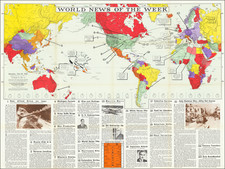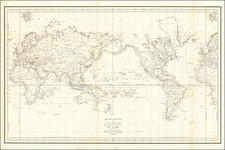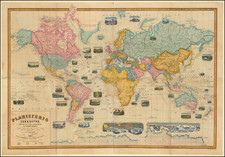The World on a Polar Gnomonic Projection -- The Sundial Map
Nice example of this unusual map of the world, often referred to as the Sundial World map, created in Nuremberg by Franz Ritter.
Ritter's map is the only known example of a map of the world utilizing the Gnomonic Projection. Noted World map scholar Rodney Shirley describes Ritter's work as a "most unusual map," being "projected from the North Pole as if it were the table of a sundial, with the landmasses drawn to scale in proportion to their distance from this point. The map is thus highly distorted according to normal conceptions but it is nevertheless mathematically correct".
Ritter's unusual projection covers a significant portion of the World, omitting the eastern part of Asia, the western part of South America or the unknown Southern Continent. The construction of the map causes an enlargement of landmasses, the farther they are from the North Pole.
The nature of the projection creates a wildly distorted treatment of Africa, most notably with the bizarre elongation of Africa and especially Madagascar. The southernmost part of Africa and South America do not appear. A massive river in North America is an early projection of the Mississippi River, which is separated from the St. Lawrence by a wide chain of Mountains.
Within North America, Virginia, Norembega (New England), Charlefort and Florida appear prominently. A wide open invitation is shown for the Northweast Passage.
In South America, a massive distinctive Orinoco River is present, with fascinating anthropomorophic headless creatures south of Lake Parime, which shows Manoa, legendary site of El Dorado. Further south, the continent is dominated my its major rivers and curious life forms.
While the projection is unusual, it has its roots in sound mathematic theory. As noted by Snyder in volume III of the History of Cartography:
The gnomonic projection has a direct connection with sundial design. The angles between the hour markings on a sundial designed for a particular latitude are identical with the angles between the meridians on a gnomonic projection centered at the same latitude, counting each 15 degrees of longitude from the central meridian as one more hour from noon. To allow one to read time, the gnomonic map is first rotated so that the north pole is south of the center of projection rather than north. Then the triangular gnomon of the sundial is placed with its base along the central meridian and its shadow-casting back touching the north pole on the map. The local sun time is indicated by the meridian along which the shadow of the sun then falls.
The map is embellished with a 16 point compass rose in the style of the 16th Century Lafreri maps, with the names of the winds shown. The seas are filled with unusual creatures, mer-people and sailing vessels.
In modern times, Ritter's maps have become highly sought after as a remarkable combination of cutting edge math, interesting early cartographic projections, carto-myths and fanciful embellishments.
Ritter was a German mathematician, cartographer, and astronomer, active in in the first part of the 17th century.
Ritter's most noteworthy accomplishment was his development of an unusual gnomic projection and his so-called “sundial” world map.
A native of Nuremberg, He had studied under Johann Praetorius at the University of Altdorf. Ritter specialized in the design and manufacture of astrolabes, sundials, and other astronomical, horological and cartographical instruments.









![(World - First State!) Benedict Arias Montanus Sacrae Geographiae Tabulam ex Antiquissimorum Cultor. [Pre-Dutch Discovery Depiction of Australia]](https://storage.googleapis.com/raremaps/img/small/93232.jpg)

![[ World Atlas ] [ Composite Atlas of the World including important American maps and Whiston's Scheme of the Solar System ]](https://storage.googleapis.com/raremaps/img/small/100165.jpg)


